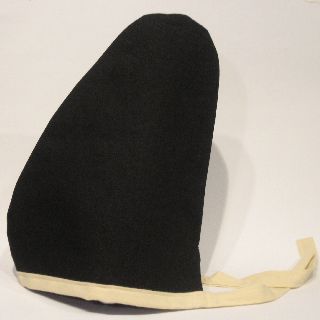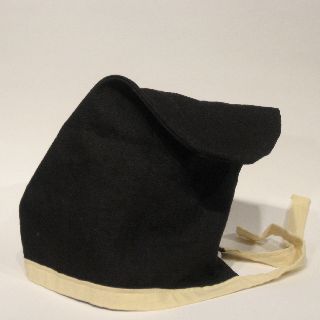A Pair of Eboshi
Japanese Ceremonial Headwear


September 2007


September 2007
The eboshi is a basic cloth cap, worn in different ways by different social strata. Simple eboshi are worn under other headwear such as straw hats, but lacquered and shaped eboshi are formal headwear on their own.
To go with the rest of my Japanese Garb, I decided to make a soft eboshi for casual wear, and a stiffened eboshi for semi-formal occasions.
The black portions of both eboshi are a heavy black linen fabric. The light portions are a soft yellow pastel linen. The stiffened eboshi is lined with buckram. Technically, the light portions should be white, and not pastel yellow. However, I had the yellow and not white, and I am from Pittsburgh.
The most difficult part of this project was getting the size and shape of the crown just right. The first eboshi I made was way too large and tall. That's a pain, but it was easy to disassemble and cut down.
Below, you can see the general shape of the crown. I used a circular coaster and a ruler to get the curves and lines right. Note that the front and back at the bottom are basically vertical. Duplicate this shape onto your dark fabric, then add a seam allowance all the way around. You'll need two pieces, of course.

If you're using buckram to stiffen your eboshi, cut two pieces of that as well. Don't add the seam allowance, though, just cut the shape. Sew these two pieces together as close to the edge as you can. (You won't be turning them.)
To make the band/ties, cut a quarter panel about a yard long (a rectangle about 36 inches long and four inches wide). Fold this in half along the long axis and press. Fold the raw edges inside the fold, right up to the crease, and press again. The band should now be about an inch wide.
Pin the two crown pieces right sides together, and stitch along the marked seam line from the center front to about two inches above the bottom in the back. Turn the crown right-side out. If you are lining the eboshi, slide the buckram lining inside now.
At the gap in the back, fold the raw edges of the opening inside twice by about a quarter inch. Sew these narrow hems down. You might also want to sew a tacking stich across the seam at the top of this opening.
Finally, insert the bottom edge of the crown between the layers of the band, all the way down to the crease. Sew through all layers, about a quarter inch from the edge. If you try to sew too close to the edge, you might miss the furthest layer and have to fix it by hand. Don't forget to finish the ends of the ties.
That's it!
In this picture, you can see the black linen of the crown, and the way it is folded into the split at the back (see below). You can also see the yellow linen of the band, and the way it is both inside and outside the crown. Lastly, you can see the white buckram lining and the way the raw edges of the buckram are covered by the band and the folded part of the crown.

After making these two eboshi, I wound up making a whole stack of them. Some friends of ours were being crowned, and they decided on some Japanese-themed shtick for coronation day. In period, every formally-dressed courtier would be wearing an eboshi, but this garb accessory is frequently overlooked by the re-enactor. So, I sat down and made ten of them to hand out to people who might not have one. Most of them were just floppy linen, but some of them were lined with a thick polyester interfacing to make them stand up. A stiffened eboshi was worn by the Prince/King during coronation, and stiffened eboshi were worn by heralds and other high courtiers. It was really fun making a bunch of these at once, and I was happy to make the coronation event spiffier.
This was so successful that I have received requests and should make a bunch more. I even sold one of the last remaining ones to a random gentleman at Pennsic 38 who was directed to our camp by a merchant!